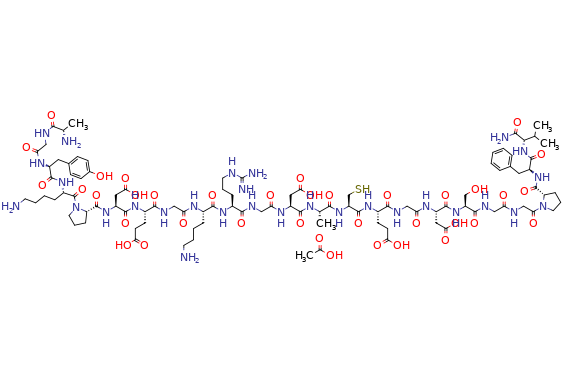
Rusalatide acetate
CAS No. 875455-82-6
Rusalatide acetate( TP508 amide acetate )
Catalog No. M22514 CAS No. 875455-82-6
Rusalatide acetate (TP508 amide acetate), a regenerated peptide, alleviates radiation-induced gastrointestinal injury by activating stem cells and protecting recess integrity.
Purity : >98% (HPLC)
 COA
COA
 Datasheet
Datasheet
 HNMR
HNMR
 HPLC
HPLC
 MSDS
MSDS
 Handing Instructions
Handing Instructions
| Size | Price / USD | Stock | Quantity |
| 5MG | 410 | In Stock |


|
| 10MG | 591 | In Stock |


|
| 25MG | 888 | In Stock |


|
| 50MG | 1224 | In Stock |


|
| 100MG | 1647 | In Stock |


|
| 200MG | Get Quote | In Stock |


|
| 500MG | Get Quote | In Stock |


|
| 1G | Get Quote | In Stock |


|
Biological Information
-
Product NameRusalatide acetate
-
NoteResearch use only, not for human use.
-
Brief DescriptionRusalatide acetate (TP508 amide acetate), a regenerated peptide, alleviates radiation-induced gastrointestinal injury by activating stem cells and protecting recess integrity.
-
DescriptionRusalatide acetate (TP508 amide acetate), a regenerated peptide, alleviates radiation-induced gastrointestinal injury by activating stem cells and protecting recess integrity.Rusalatide (TP508) is a 23 amino acid peptide representing amino acids 508-530 of human prothrombin that was identified as the high-affinity binding domain of thrombin responsible for interaction with a subset of thrombin receptors on the surface of fibroblasts thought to initiate tissue repair.
-
In VitroRusalatide (TP508) is a 23 amino acid peptide representing amino acids 508-530 of human prothrombin that was identified as the high-affinity binding domain of thrombin responsible for interaction with a subset of thrombin receptors on the surface of fibroblasts thought to initiate tissue repair.
-
In Vivo——
-
SynonymsTP508 amide acetate
-
PathwayOthers
-
TargetOther Targets
-
RecptorOthers
-
Research Area——
-
Indication——
Chemical Information
-
CAS Number875455-82-6
-
Formula Weight2371.5
-
Molecular FormulaC99H151N29O37S
-
Purity>98% (HPLC)
-
SolubilityH2O:soluble
-
SMILESCC(O)=O.CC(C)C(NC(=O)C(CC1=CC=CC=C1)NC(=O)C1CCCN1C(=O)CNC(=O)CNC(=O)C(CO)NC(=O)C(CC(O)=O)NC(=O)CNC(=O)C(CCC(O)=O)NC(=O)C(CS)NC(=O)C(C)NC(=O)C(CC(O)=O)NC(=O)CNC(=O)C(CCCNC(N)=N)NC(=O)C(CCCCN)NC(=O)CNC(=O)C(CCC(O)=O)NC(=O)C(CC(O)=O)NC(=O)C1CCCN1C(=O)C(CCCCN)NC(=O)C(CC1=CC=C(O)C=C1)NC(=O)CNC(=O)C(C)N)C(N)=O
-
Chemical Name——
Shipping & Storage Information
-
Storage(-20℃)
-
ShippingWith Ice Pack
-
Stability≥ 2 years
Reference
1.Kantara C, et al. Novel regenerative peptide TP508 mitigates radiation-induced gastrointestinal damage by activating stem cells and preserving crypt integrity. Lab Invest. 2015 Nov;95(11):1222-33.
molnova catalog



related products
-
Torachrysone gentiob...
Torachrysone gentiobioside is a phenolic glycoside isolated from cassia seeds.
-
1-Phenylpyrrole
1-Phenylpyrrole is an inhibitor of CYP450 dependant monooxygenase activity in microsomes from rat liver.
-
Lithospermate B
Lithospermate B is a natural product activates eNOS and ameliorates endothelial dysfunction in diabetes by enhancing vasodilation in addition to reducing oxidative stress, it can protecte cardiomyocytes from ischemic injury through specific inhibition of TAB1-p38 apoptosis signaling.



 Cart
Cart
 sales@molnova.com
sales@molnova.com


